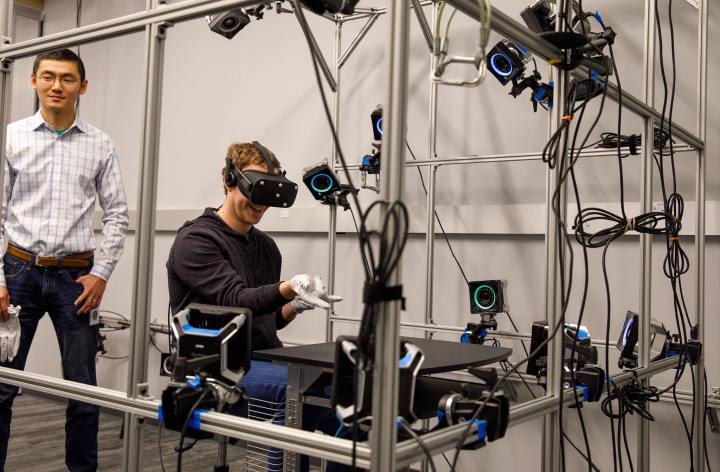
Picking things up in virtual reality usually involves pushing a button on a touch controller, and it’s not exactly the most immersive part of a VR experience — it’s a constant reminder that you’re not actually interacting with anything. Oculus might be gearing up to change that with a set of VR gloves described in a pair of patent filings made public on Thursday, March 22.
It’s not the first time we have seen this kind of technology introduced to as a VR peripheral, and it’s also not the first time Oculus has dropped hints that it is working on this kind of technology. In February, Facebook CEO Mark Zuckerberg teased the Oculus VR gloves in a Facebook post, and these patents shed some light on just what was going on inside those fancy white gloves.
“The haptic feedback mechanism includes a composite extendible ribbon coupled to a glove digit of a glove body. The glove digit is configured to be work around a [finger] of a user’s hand,” the patent reads.
The patents describe a pair of gloves that include internal “tendons” that tense and relax in order to simulate your sense of touch in VR. Normally when you touch something or pick something up, the pressure you experience in your fingertips is from your hand pressing against the object itself. These gloves work on the opposite principle — the tendons that run on the backside of the gloves are designed to offer resistance to your hand movements, simulating what it feels like to touch an object.
“The haptic feedback facilitates an illusion that a user is interacting with a real object when in fact the object is a virtual object,” the patent continues. “The mechanism resists movement by one or more portions of a user’s body.”
Think of it like tying a string to each one of your fingers and pulling up on those strings from behind your hand. It’s going to make clenching your fingers difficult, that kind of resistance is the exact kind of resistance these gloves use to simulate touch. On its own, it wouldn’t really feel like you were grasping an object, it would feel like something was pulling on your hand. But coupled with a VR headset, immersive sound, these kinds of physical cues can be the difference between a sort of immersive experience, and a truly immersive VR experience.
Editors' Recommendations
- This new VR headset beats the Vision Pro in one key way and is half the price
- A cheaper version of the Meta Quest 3 now seems more likely than ever
- The Apple Vision Pro has given VR its iPhone moment
- Apple’s VR headset could launch early, and that’s risky
- Apple’s XR headset could get one of the Mac’s best features


